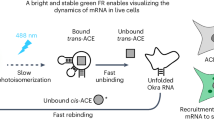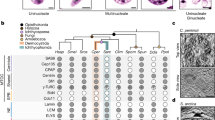Abstract
IN Drosophila hydei salivary glands, a puff can be induced by treatment with vitamin B6 (ref. 1) at locus 2-48 BC. This puff is one of the series that can also be induced by temperature shock, anaerobiosis or treatments interfering with the respiratory metabolism2. A product of this puff seems to be a giant ribonucleoprotein (RNP) complex (diameter up to 4,000 Å) with a very specific morphology3. This complex consists of a core and a cortex, formed by a wreath of small particles (diameter approximately 300 Å; ref. 4). Cytochemical analysis has shown that the core of the complex is essentially free of RNA whereas the cortex does contain RNA4. Using phospho-tungstic acid (PTA) as a specific stain for proteins, it could also be shown that the proteins from the cortex are relatively rich in arginine and lysine residues whereas those in the core are relatively poor in such residues5. No similar puff product has so far been found in any other locus of D. hydei. In addition to the giant RNP complexes small RNP particles (diameter up to 300 Å; not to be confused with the particles from the cortex) can also be seen in this puff2,5. A comparison of data from both ultrastructural and autoradiographical studies on RNA formation at locus 2-48 BC has led to the conclusion that the small RNP particles present in this puff aggregate to the giant RNP complexes and thus give rise to the final puff product6. This conclusion is in agreement with the finding of a single RNA species in puffs obtained by microdissection of salivary glands7. Although the small RNP particles in the puff have not been studied extensively, it has been assumed that, based on the presence of RNA and arginine and lysine residues, the small particles form the cortex of the complex5, leaving the origin of the cortex proteins still obscure. Here I present the results of a comparison between the staining of the small RNP particles with that of the components of the giant complexes. These studies indicate that the same components of the small RNP particle become part of the core of the complex after aggregation.
This is a preview of subscription content, access via your institution
Access options
Subscribe to this journal
Receive 51 print issues and online access
$199.00 per year
only $3.90 per issue
Buy this article
- Purchase on Springer Link
- Instant access to full article PDF
Prices may be subject to local taxes which are calculated during checkout
Similar content being viewed by others
References
Leenders, H. J., Derksen, J., Maas, P. M. J. M., and Berendes, H. D., Chromasoma, 41, 447–460 (1973).
Leenders, H. J., Berendes, H. D., Helmsing, P. J., Derksen, J., and Koninkx, J. F. J. G., Sub-Cell. Biochem., 3, 119–147 (1974).
Berendes, H. D., Symp. Soc. exp. Biol., XXV, 145–161 (Cambridge University Press, London and Cambridge, 1971).
Derksen, J., Willart, E., and Berendes, H. D., J. Cell Biol., 59, 661–668 (1973).
Derksen, J., and Willart, E., Chromosoma, 55, 57–68 (1976).
Berendes, H. D., in Results and Problems in Cell Differentiation, 4 (edit. by Beermann, W.), 181–207 (Springer, Berlin, 1972).
Bisseling, T., Berendes, H. D., and Lubsen, N. H., Cell (in the press).
Luft, J. H., J. Cell Biol., 25, 407–408 (1965).
Venable, J. H., and Coggeshall, R. J., J. Cell Biol., 25, 407–408 (1965).
Bloom, F. E., and Aghajanian, G. K., J. Ultrastruct. Res., 22, 361–375 (1968).
Palladini, G., Lauro, G., and Basile, A., Histochemie, 24, 315–321 (1970).
Author information
Authors and Affiliations
Rights and permissions
About this article
Cite this article
DERKSEN, J. Ribonuclear protein formation at locus 2-48 BC in Drosophila hydei. Nature 263, 438–439 (1976). https://doi.org/10.1038/263438a0
Received:
Accepted:
Issue Date:
DOI: https://doi.org/10.1038/263438a0
This article is cited by
-
A comparative ultrastructural study of ?glue? production and secretion of the salivary glands in different species of theDrosophila melanogaster group
Wilhelm Roux's Archives of Developmental Biology (1979)
Comments
By submitting a comment you agree to abide by our Terms and Community Guidelines. If you find something abusive or that does not comply with our terms or guidelines please flag it as inappropriate.



